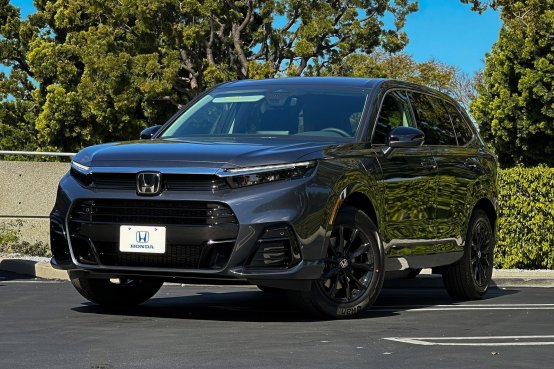The 2025 Honda CR-V continues to be a benchmark in the compact SUV class, offering a refined balance of functionality, efficiency, and comfort. Available in both standard and hybrid variants across multiple trims, it caters to a wide range of drivers seeking dependable performance, modern features, and strong long-term value.

Overview and Design
Carrying forward the sixth-generation platform introduced in 2023, the 2025 CR-V refines its familiar and well-proportioned design. The updated model features a bold front grille, sculpted side panels, and sleek LED accents that project a contemporary yet confident presence. Honda’s design approach emphasizes practicality without compromising on visual appeal.
Inside, the CR-V’s cabin benefits from higher-quality materials and better digital integration. The intuitive infotainment interface and ergonomic control layout enhance ease of use for both drivers and passengers. Early feedback highlights the model’s spaciousness, quiet ride, and premium touches—though some owners note that its handling favors comfort over dynamic cornering agility.
Performance and Powertrain Options
The 2025 CR-V maintains its familiar powertrain options. The standard 1.5-liter turbocharged four-cylinder engine produces around 190 horsepower and 179 lb-ft of torque, paired with a refined continuously variable transmission (CVT). The hybrid model pairs a 2.0-liter engine with twin electric motors, generating approximately 204 horsepower while offering improved fuel economy and responsiveness. Most trims are available with either front- or all-wheel drive.
On the road, the CR-V demonstrates composed handling and predictable performance suited for daily driving. While not sporty, its stability and smooth ride are frequently praised. The hybrid variant stands out for its quiet operation, instant torque, and better low-speed drivability compared to earlier models. Honda’s suspension system ensures excellent ride comfort while maintaining solid control over uneven surfaces. The towing capacity remains modest—around 1,500 pounds for standard versions and 1,000 pounds for hybrids.
Interior, Space, and Comfort
Honda continues to focus on occupant comfort and usability. The CR-V offers generous rear legroom—approximately 39.3 inches—and ample cargo capacity, with 39.3 cubic feet available behind the second row and up to 76.5 cubic feet when the seats are folded.
The dashboard follows a minimalist, horizontally oriented layout featuring a 7-inch digital display (upgradable to 9 inches on higher trims) and an easy-to-access infotainment system. Upgraded materials, additional soft-touch surfaces, and improved trim detailing create a more refined atmosphere. The seats provide excellent lumbar support and adjustability, ideal for longer trips. Enhanced insulation contributes to a quiet, composed cabin environment, especially noticeable during highway driving.
Fuel Efficiency and Economy
Efficiency remains a defining quality of the CR-V. Turbocharged variants achieve an estimated 28 mpg city, 34 mpg highway, and 30 mpg combined in front-wheel-drive form, with slightly lower numbers for all-wheel-drive configurations.
The hybrid lineup offers even better performance, averaging around 43 mpg city, 36 mpg highway, and 40 mpg combined for FWD models, and roughly 40 mpg city, 34 mpg highway, and 37 mpg combined for AWD versions. Drivers report that real-world mileage often aligns with EPA estimates, particularly in stop-and-go urban settings where the hybrid system optimizes battery usage. Short-distance electric-only operation enhances fuel savings and reduces emissions, making it especially appealing for city dwellers.
Market Position and Value Retention
In a competitive segment featuring the Toyota RAV4, Mazda CX-5, Hyundai Tucson, and Ford Escape, the 2025 CR-V continues to shine through its reliability, efficiency, and practicality. The RAV4 maintains an edge in hybrid variety, the CX-5 excels in sportier driving dynamics, the Tucson leads in technology and warranty, and the Escape focuses on innovative powertrains.
SUV Model | Starting MSRP (est.) | Key Strengths | Fuel Economy (combined) |
2025 Honda CR-V | $28,500 - $39,000 | Reliability, interior comfort, hybrid efficiency | 30–40 mpg |
2025 Toyota RAV4 | $28,000 - $42,000 | Powertrain variety, strong resale value | 30–41 mpg |
2025 Mazda CX-5 | $27,500 - $40,000 | Handling, premium materials | 26–28 mpg |
2025 Hyundai Tucson | $27,000 - $38,500 | Warranty, modern design | 29–38 mpg |
2025 Ford Escape | $28,000 - $39,500 | Technology, engine flexibility | 28–37 mpg |
(Estimates subject to change; verification recommended before purchase.)
Thanks to Honda’s consistent track record for durability and reliability, the CR-V continues to retain strong resale value, with projected three-year residuals above 60%. This dependable reputation, combined with its comfort, fuel efficiency, and balanced performance, makes the 2025 CR-V one of the most appealing compact SUVs available for buyers seeking a practical yet refined driving experience.
